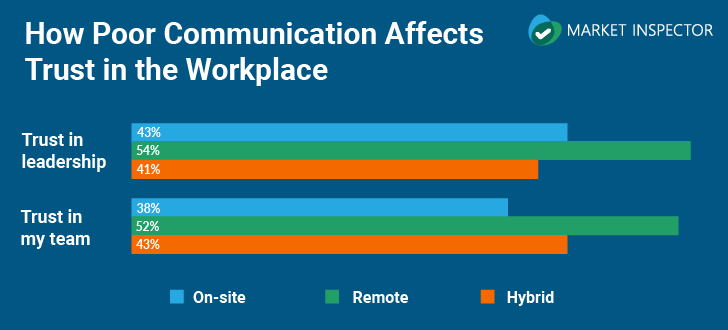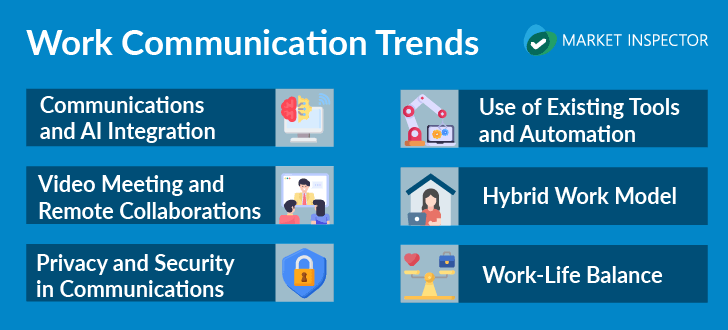- Market-Inspector.co.uk
- Communication in the Workplace
Workplace Communication Statistics (2025)

The modern business landscape is constantly evolving. The rise of remote work and increasingly diverse teams necessitates critically evaluating internal communication strategies. Effective communication in the workplace within organisations, regardless of size, is no longer a luxury but a key driver of employee productivity.
Yet reality bites: Microsoft states that 68% of employees lack uninterrupted focus time during the workday. Moreover, workers spend 57% of their time communicating in meetings, email, and chat. While effective communication in the workplace is essential for today's diverse and remote teams, it can't come at the expense of focused work. Therefore, finding a balance in workplace communication is crucial.
This article explores the bigger picture of workplace communication, diving into key communication statistics that reveal the challenges and opportunities.
By understanding these communication statistics and facts, you'll gain valuable insights to build a communication strategy that fosters collaboration, boosting team productivity and employee satisfaction.
Why is communication important in the workplace?

Effective communication in the workplace is crucial for various aspects of organisational performance. Here are some statistics that demonstrate the benefits of effective communication in the workplace:
Benefit #1: Increased productivity
72% of business leaders believe effective communication has increased their team's productivity.
Research by McKinsey shows that well-connected teams can increase their productivity by 20-25%. Additionally, the same research highlights that companies with effective communication strategies outperform their competitors by 3.5 times.
Benefit #2: Improved engagement
Effective communication in the workplace positively affects employees' productivity, engagement, retention, and trust.
Gallup has found that managers play a significant role in employee engagement, accounting for 70% of the variance between a good and mediocre workplace. The same research emphasises that more than one-time communication efforts are required.
Repeating important messages through various channels is crucial for employees to take notice, believe, and act on them.
Benefit #3: Increased retention
According to ZenHR, effective team communication increases employee retention by 4.5 times compared to workplaces without an effective communication strategy.
On top of that, 80% of employees are unlikely to look for a new job when they feel recognised, demonstrating the retention benefits of good communication.
The same report states that 95% of HR departments blame the loss of good employees on job burnout, which can be mitigated by clear communication and reasonable expectations.
This said, frequent, transparent communication with clear expectations that recognise contributions and support work-life balance is crucial for retaining top talent and reducing burnout and turnover.
Benefit #4: Increased trust
Trust is a vital factor for growth and productivity in any organisation. Research by MIT Sloan highlights that trusting employees are 260% more motivated to work, have 41% lower turnover rates, and are 40% more productive.
These statistics demonstrate the significant impact that effective communication can have on various aspects of organisational performance. This includes productivity, engagement, retention, and trust.
Statistics on poor communication in the workplace
According to Forbes, over 40% of workers experience a decline in trust towards leadership and their team when communication is lacking. This is especially true for remote workers, where over half (54% leadership, 52% team) reported a trust gap due to communication issues.
Even on-site workers are affected, with nearly half experiencing a decline in trust (43% leadership, 38% team). Clear and consistent communication strategies can significantly improve employee trust and foster a more positive work environment.

The consequences of poor communication reach far beyond a lack of trust. For both employees and businesses, it can have a significant ripple effect:
Consequence #1: Burnout and decreased productivity
According to research by Deloitte, 77% of professionals have experienced burnout in their current jobs. This isn't surprising when we consider the impact of unmanageable stress (91% say it affects work quality) and work-life imbalance. As a result, burnout can cripple productivity, increase absenteeism, and even lead to health problems.
Consequence #2: Professional failures
According to Gallup, poorly communicated objectives and expectations can prevent employees from contributing to discussions and tasks. Also, a lack of communication means that employees may waste time by duplicating tasks or missing deadlines. On top of that, strained team relationships and an unbalanced work environment can quickly develop due to poor communication.
At the same time, the above-mentioned research states that only 7% of employees strongly agree that communication in the workplace is accurate, open, and timely.
Consequence #3: Financial cost to businesses
In 2023, Grammarly shared that miscommunication costs US businesses $12,506 (£11,560) per employee each year.
According to the same research, 20% of businesses admitted that poor communication damaged their brand reputation, which led to lost deals in 19% of cases.
Statistics on the most used languages in business communication

In today's interconnected world, speaking the right language is essential for international success. Here's a breakdown of the top languages used in global business communication in 2025.
-
English: English is spoken by over 1.5 billion people worldwide and is the official language of major economies like the US, UK, and Canada. It's vital for communication, negotiation, and trade across borders.
-
Mandarin Chinese: With 1.15 billion speakers, Mandarin is crucial for tapping into the vast Chinese market, a leader in manufacturing, technology, and e-commerce.
-
Spanish: Spoken by 559 million people globally, Spanish opens doors in Latin America and the US, where it's a key language for commerce.
-
German: German is essential for doing business in Europe, particularly in powerhouses like Germany, Austria, and Switzerland. It's also important in scientific and research circles.
-
Arabic: The growing economies of the Middle East and parts of Africa make Arabic increasingly important, with 360.5 million native speakers.
-
French: French, spoken by 300 million people worldwide, provides access to established and emerging markets in Africa, Europe, and Canada.
- Japanese: Japan's dominance in technology and innovation makes Japanese a valuable asset for businesses seeking to enter that market.
These languages are key because of the number of speakers and the economic, cultural, and diplomatic clout they represent.
It's worth noting that navigating language barriers and differing communication styles is one of the primary challenges in modern cross-cultural communication. For instance, nuances and subtleties can get lost in translation when English is used as the lingua franca (common language) in European business settings, leading to potential miscommunication.
Research from McKinsey found that enterprises with racially and ethnically diverse leadership have a 36% advantage in achieving financial outperformance.
Statistics on workplace communication after COVID-19
The COVID-19 pandemic has significantly impacted workplace communication practices. Here are some statistics that highlight the changes and challenges faced by employees and organisations:
- Remote work: 45% of employees work from home due to the pandemic, which has increased the need for effective remote communication.
- Communication challenges: 70% of employees reported difficulties in communicating with colleagues while working from home, particularly regarding spontaneous communication and teamwork.
- Productivity: Despite the challenges, 60% of employees reported positive productivity while working from home, with 40% of employees feeling more productive.
- Communication strategies: Effective communication strategies are crucial in mitigating the spread of COVID-19. Research suggests that communication can increase adherence to protective behaviours by 20-30%.
- Leadership communication: 75% of employees would prefer their managers to communicate more effectively.
- Employee engagement: 60% of employees reported feeling more engaged when they receive regular updates from their managers.
- Communication infrastructure: According to a paper on Frontiers, 21% of those responsible for internal communication lack a plan, and 60% of companies still need to implement long-term strategies for communication infrastructure.
Apart from that, research on Nature.com states that during COVID-19, meetings have become more frequent, with an increase in the number of meetings per person (+12.9%) and the number of attendees per meeting (+13.5%). However, the average length of meetings has decreased (-20.1%).
Consequently, internal communicators are now seen as critical to the success of organisations. They ensure effective communication and collaboration between departments. They are responsible for implementing the right technologies to support digital transformation and employee productivity.
Statistics on the communication devices and platforms people use in the workplace

The modern workplace communication landscape is diverse, with a mix of traditional and modern methods in play. Businesses that adapt their communication strategies accordingly can better foster collaboration, knowledge sharing, and a productive work environment.
According to Forbes research, on-site workers favour in-person conversations (34%), while remote workers rely more on email (25%). Younger generations (18-42) prefer email and direct messages, while older generations (59-77) favour in-person conversations.
Email is preferred for broadcasts at 92% of organisations, while manager meetings (81%) and chat tools (79%) are used more for collaboration.
Tools like Microsoft Teams, Zoom, Google Chat, Google Meet, Discord, Slack, and mobile phones on top of it are leading ways to bridge the gap between on-site and remote workers.

In summary, email, video calls, direct messages, and in-person conversations are among the most preferred communication methods in the workplace. These preferences vary based on factors like remote/on-site work, age, and the specific communication need (broadcast vs. collaboration).
Work communication trends for 2025

Current trends highlight the evolving landscape of workplace communication, focusing on leveraging technology, enhancing collaboration, and addressing the challenges posed by remote and hybrid environments.
Expectedly, AI-driven collaboration assistants are becoming integral parts of communication platforms. And 64% of professionals believe that AI will significantly impact the communication sector in the next 5 years.
Asynchronous communication is on the rise, with tools like Slack and Async enabling teams to stay connected and aligned without the need for constant real-time interaction. This trend allows for more flexibility and productivity, especially in remote and hybrid work settings.
Video communication continues to dominate, with 85% of professionals preferring video for important conversations. However, the focus is shifting towards more authentic and inclusive video experiences, emphasising accessibility features and natural interactions.
Workplace communication is also becoming more personalised, with 60% of employees expecting tailored communication experiences based on their roles, locations, and preferences. Effective communication strategies now involve segmentation, targeted messaging, and multi-channel delivery.
As the lines between work and life continue to blur, there is a growing emphasis on empathetic communication. Leaders are expected to prioritise employee well-being, foster open dialogues, and create a culture of trust and support.
In summary, the future of workplace communication is characterised by intelligent automation, multilingual capabilities, asynchronous collaboration, video-centric interactions, personalised experiences, and empathetic leadership. Organisations that embrace these trends will be well-positioned to navigate the evolving communication landscape and drive success in the years ahead.
We strive to connect our customers with the right product and supplier. Would you like to be part of Market Inspector?

